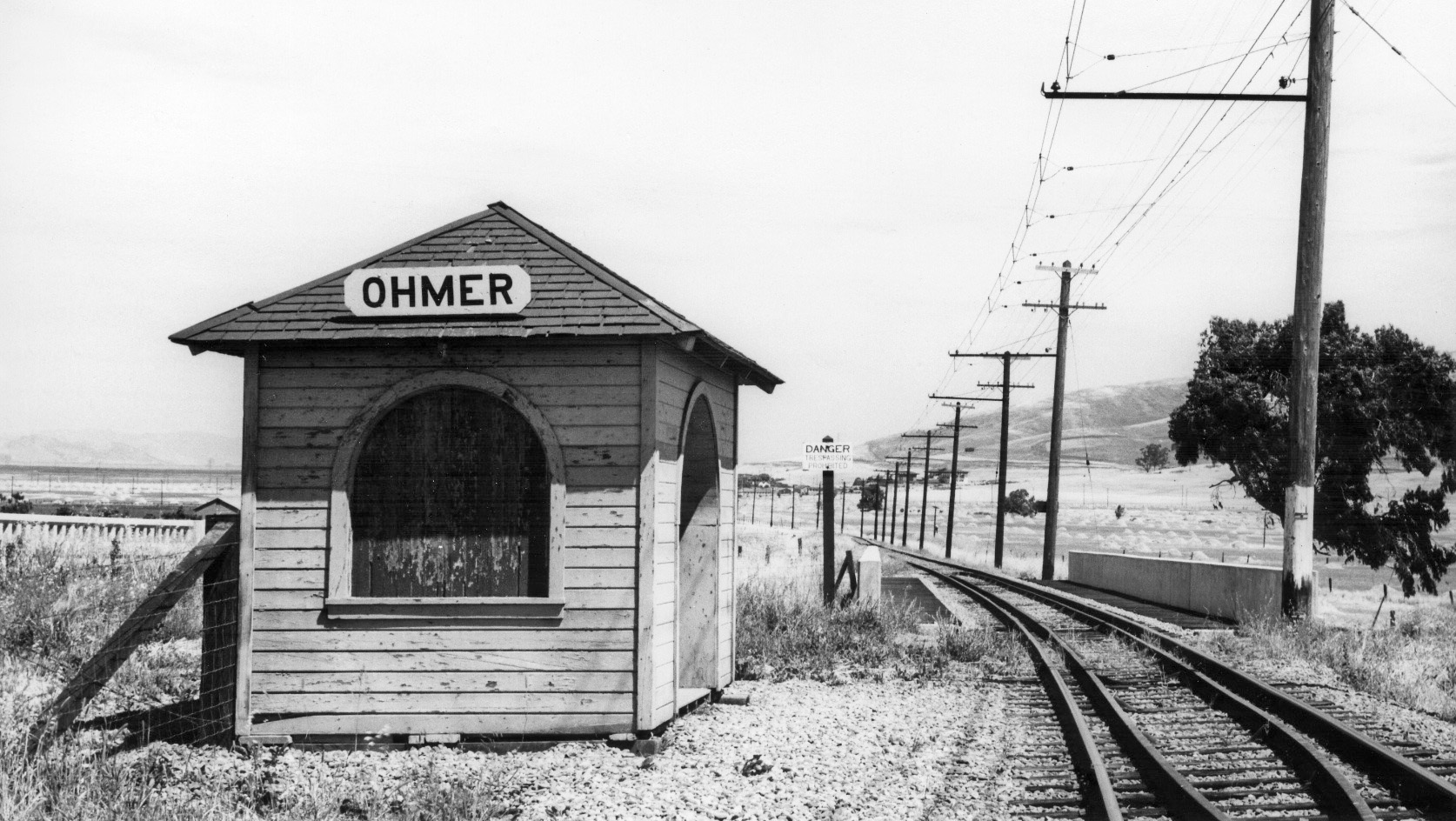What’s an Ohmer?

A north view of the Ohmer shelter on May 18, 1940. The shelter is no longer in use. The scene is in an agricultural valley rimmed by bare hills and the presence of an overpass. First, where is Ohmer?
L144-05-Wilbur C Whittaker Photo, Courtesy Tom Gray, (Image 1 of 15)

Ohmer was the previous name given to the northwest tip of Concord. The circa 1920s map shows it along the Port Chicago Highway between Adeline and Clyde. Before dissecting the SN history and the physical details of this locale, first to ask what is an Ohmer?
L144-10-Courtesy California Board of Equalization 862-7-5B, (Image 2 of 15)

Ohmer refers to a Dayton, Ohio-based company that began manufacturing fare registers at about the turn of the 20th century for trains and street cars, and subsequently for taxis and buses. Their success led to creation of various ticket printing and issuing machines and fare boxes. The type of register shown here for SN 1005 in 1951 was activated by the turn and pull of the pole coming in from the conductor present somewhere in the car.
L144-15-Grant Ute Collection, Courtesy BAERA, Western Railway Museum Archives, 71082sn, (Image 3 of 15)

This example of a print out from the Ohmer fare register device provided the accounting of a daily train run. John Francis Ohmer, Sr. founded the company in 1898 as Ohmer Car Register Co. based on his first invention. According to his obituary in the New York Times and http://ohmer.org/john-francis-ohmer/, he was instrumental in the designs and improvements of the fare registers leading to the fully matured Ohmer Fare Registry Company in 1902, hereon in to be referred to as “Ohmer”.
L144-20-Courtesy BAERA, Western Railway Museum Archives, 40881, (Image 4 of 15)

This invoice from June 30, 1912 indicates that the Ohmer devices were utilized early in the SN’s timeline on the Oakland and Antioch trains. Electric Traction - Volume 8 - Page 794 from July 1912 indicated that the Ohmer Fare Register Company had moved into a new 74,000 sq. ft. plant to expand their manufacturing efforts.
L144-25-Courtesy BAERA, Western Railway Museum Archives, 40881, (Image 5 of 15)

The contractual relationship of Ohmer and the SN continued through the Oakland, Antioch and Eastern Railway era. John F. Ohmer, Sr. had originally been in and continued his other line of work inherited from his father, the furniture business, until 1927. While selling furniture to electric railway, it was said he saw the need for a device that could register fare collections.
L144-30-Courtesy BAERA, Western Railway Museum Archives, 40881, (Image 6 of 15)

Outfitting the Oakland, Antioch and Eastern trains was evident by the rental of 18 registers by early 1915. In that year, John F. Ohmer, Sr. had invented a receipt-printing taximeter and eventually mileage recorders, these efforts increasing the company’s scope. During WWI, he offered and was accepted by the government to produce gun sights and mounts.
L144-35-Courtesy BAERA, Western Railway Museum Archives, 40848, (Image 7 of 15)

Ohmer introduced the number 62 register in 1922 as documented in this August 19, 1922 article. Here presented are the details of the operation of register. Ref: Transit Journal-Electric Railway Journal, Volume 60 #8, pages 269-70 McGraw-Hill Publishing Co., Digitized by Google.
L144-40-Courtesy Google Books, (Image 8 of 15)

The two companies continued fare register rental agreements into 1926, surviving the Oakland, Antioch and Eastern’s foreclosure in 1920 and the formation of the San Francisco-Sacramento Railroad, the SF-S.
L144-45-Courtesy BAERA, Western Railway Museum Archives, 40881, (Image 9 of 15)

On May 24th, 1926, Harry Mitchell, the Vice President and General Manager of the SF-S, informed John Ohmer that they would discontinue use of the fare registers without providing any details for the basis of this decision.
L144-50-Courtesy BAERA, Western Railway Museum Archives, 40881, (Image 10 of 15)

Some insight into the SF-S’s decision is gained in this letter from JB Rowray of the Sacramento Northern Railroad to Harry Mitchell in March, 1927, the two train lines soon to be merged as the SN via the Western Pacific. Rowray wondered about the need for the complex Ohmer register given the practice now adopted for the train conductor to provide a receipt to the passenger.
L144-55-Courtesy BAERA, Western Railway Museum Archives, 40881, (Image 11 of 15)

In reply to Rowray, Mitchell indicated that the number 62 registers had been removed in 1926 and a new cash fare receipt system of their own design implemented, this process still under review.
L144-60-Courtesy BAERA, Western Railway Museum Archives, 40881, (Image 12 of 15)

In this final correspondence found in the file between Ohmer and Mitchell, an unsuccessful last pitch for a contract for new registers was made in 1927, citing a previous comment from Mitchell about the high expense of using the registers. Given the Los Angeles address, “Jay” was likely John Ohmer’s son. Some information his son can be found at http://ohmer.org/john-francis-ohmer-jr/. John Ohmer, Sr. passed away on Nov. 4, 1938 at age 82.
L144-65-Courtesy BAERA, Western Railway Museum Archives, 40881, (Image 13 of 15)

Ohmer survived the Depression as seen in this 1939 interior view toward the bulkhead of a Pacific Electric 400 class car. The Rockwell Manufacturing Co. of Pittsburgh, Pa. acquired Ohmer in 1946, and renamed it as a division of the company, the Rockwell Register Corporation of Bellefontaine, Ohio. For more details, see http://vintagemachinery.org/pubs/698/2348.pdf
L144-70-Harold F Stewart Photo, Courtesy BAERA, Western Railway Museum Archives, 44615pe, (Image 14 of 15)

Now that the origin of Ohmer has been explained, imagine having boarded this two car train at Adeline in 1941 as it heads north along the Port Chicago Highway for the next destination, Ohmer hill. Northeast view.
L144-75-Vernon Sappers Collection, Courtesy BAERA, Western Railway Museum Archives, 106461sn , (Image 15 of 15)